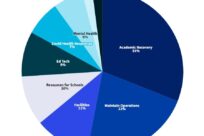While school districts and charter schools nationwide have poured billions of dollars of federal Elementary and Secondary School Emergency Relief (ESSER) funds into their educator workforces to bolster learning recovery in the wake of the pandemic, they largely have failed to detail how they have spent the money. North Carolina is an exception, and a close look at the state’s spending reports provides the most comprehensive picture to date of local education leaders’ staffing strategies as they struggle to respond to the devastating consequences of the pandemic on the nation’s students.
Congress has given states and local education agencies $189 billion to respond to the pandemic through three rounds of ESSER grants. North Carolina has received $5.6 billion of those funds, including $3.6 billion under the third round, the American Rescue Plan. As of October 31, the state’s school districts and charter schools had spent or encumbered roughly $2.3 billion, or 70 percent, of the local share of that third-round money, including $1.2 billion on staffing.
Short-term Spending
Notably, given warnings of looming post-ESSER teacher layoffs, the largest share of North Carolina’s staffing investments—and the single largest last-round ESSER expenditure of any sort—went to one-time expenditures rather than to long-term personnel commitments.
About 55 percent of North Carolina’s local education agencies chose to spend some of their third-round ESSER dollars on staff bonuses, with traditional public-school districts much more likely to use the strategy (88 percent) than charter schools (30 percent). Staffing bonuses amounted to $445 million, or 20 percent of the total third-round ESSER funds spent so far. Most of this spending occurred in fiscal year 2022, likely reflecting challenges in recruiting and retaining staff during the pandemic.
North Carolina’s state-level data does not show whether bonuses were distributed across-the-board to thank teachers for their efforts during the pandemic or targeted to support hiring and retention in hard-to-fill teaching areas. But an earlier FutureEd analysis of the nation’s 100 largest school districts’ third-round ESSER plans found that nearly half the districts that were planning to spend money on bonuses indicated that they were targeted for specific hard-to-fill positions, hard-to-staff schools, or effective teachers. Our current analysis of ESSER spending in North Carolina school districts reveals that several are using bonuses strategically to hire and keep staff in hard-to-fill jobs.
Charlotte-Mecklenburg County Schools, the state’s second largest district, for example, has spent more than $76.2 million in third-round ESSER funds on bonuses, primarily in the form of recruitment and retention incentives. Like many other districts, Charlotte-Mecklenburg experienced higher turnover and vacancy rates due to pandemic-related challenges in retaining and recruiting staff. In response, the district analyzed vacancy data and channeled bonuses toward the hardest-to-fill positions. This includes $2,500 critical shortage recruitment bonuses and $200 monthly retention incentives for K-12 special education teachers, secondary science teachers, secondary math teachers, secondary English language arts teachers, and K-12 multilingual learner teachers, as well as bonuses and incentives for bus drivers, substitute teachers, and other staff.
Similarly, Guilford County Schools, the state’s third largest district serving students from Greensboro and High Point, is targeting bonuses for hard-to-staff positions, offering $20,000 signing bonuses for newly hired teachers who meet specific criteria and agree to work for three years in one of the district’s lowest-performing schools. Union County Public Schools, a large suburban district outside of Charlotte, is offering $4,000 bonuses to teachers of English language arts, math, science, and exceptional children to fill and keep these positions at four of its schools.
Our analysis found that rural education agencies were most likely to offer staff bonuses: 63 percent of rural districts have spent money on bonuses compared to 42 percent of urban districts. “A lot of the more rural districts already face competition [for teachers], especially if they’re bordering a county or a district that is urban and can offer a larger [salary] supplement,” said Rachel Wright-Junio, director of North Carolina’s office of learning recovery and acceleration. “So, I would understand why they would take advantage of awarding bonuses to try to attract and retain teachers.”
Research has found targeted bonuses to be more effective than across-the-board stipends in attracting and retaining teachers, a fact that bodes well for Charlotte-Mecklenburg, Guilford, and other North Carolina districts struggling with deep shortages in traditionally hard-to-staff subjects like math, science, and special education. But interviews with North Carolina district leaders suggest that the sudden influx of bonus money has led to competition to retain teachers, as some districts were able to offer higher bonuses than others.
While one-time bonuses could help retain teachers and avoid the consequences of a 2024 fiscal cliff, their impact on learning loss is harder to parse. An evaluation conducted by Mathematica Policy Research of the federal Teacher Incentive Fund program, as well as a study by researchers at Vanderbilt University, suggest that performance bonuses can have a small positive effect on student achievement—the equivalent of an extra three to four weeks of learning. But the Covid bonuses are not necessarily performance-based. “We don’t truly know the impact,” says Wright-Junio. “At least from an anecdotal standpoint, I do think that if they did not give bonuses to teachers working in the summer programs and things, there would be further staffing issues. But my fear is that once these go away, once there are no more bonuses or options to award bonuses, teacher shortages, bus driver shortages may be exacerbated.”
Paying for Personnel
North Carolina school districts and charters have spent nearly $369.3 million of their third and final round of ESSER funding on staff salaries, with about one-third of the money going to classroom teacher salaries. An additional $50.2 million went for salary supplements, which are recurring extra payments given to teachers to attract and retain highly effective educators. Salary supplements are typically set at the local level and paid with local funds. Though bonuses represent North Carolina’s largest ESSER expenditure, teacher salaries emerged among the top spending priorities in two-thirds of local education agencies.
This trend aligns with FutureEd’s analysis of ESSER III plans from more than 5,000 school districts in all 50 states and the District of Columbia representing 74 percent of the nation’s public-school students. Teacher salaries were also the most common spending priority among those districts.
While North Carolina school districts spent heavily on teachers, it is unclear whether the teachers are new hires or pre-existing staff. A separate FutureEd analysis of staffing in North Carolina’s 115 traditional school districts, based on data from the NC Statistical Profile, shows that while some districts have hired additional teachers and staff in the past several years, overall it does not appear as though the funds resulted in significant staffing increases in the state’s schools.
We found that the number of North Carolina teachers supported by federal funds has risen by 23 percent, between 2018-19 and 2022-23—an increase of 1,300 teachers. But the total number of teachers across the state has declined slightly (a drop of 720 teachers) from pre-pandemic levels. This suggests that at least some ESSER money has funded existing teachers not new personnel. While some districts might be paying existing staff with ESSER dollars to free up other funds, our analysis indicates that there are now more teachers per student in classrooms across the state. The statewide student-teacher ratio declined from 15.1 in 2018-19 to 14.7 in 2022-23. Pandemic funds may have made it possible for school districts to keep teachers they might otherwise have had to let go due to student enrollment declines.
But this doesn’t necessarily indicate that all these positions will automatically disappear when the ESSER money runs out. “You don’t know the counterfactual, which might be that the district would have hired for that new position anyway and used other spending for it,” said Dan Goldhaber, director of the Center for Analysis of Longitudinal Data in Education Research at the American Institutes for Research and a FutureEd research advisor. “I think it probably indicates that some of those teachers are, in fact, going to go when ESSER disappears. But you don’t know that for sure.”
About half of North Carolina school districts and charters spent a total of $44.1 million on tutors, which includes both school-day tutors ($24.8 million) and after-school tutors ($19.3 million). It’s important to note that school-day tutors are hired and assigned to provide tutorial services as their main responsibility, while after-school tutors could be either external hires or current teachers or other staff members, receiving additional pay for tutoring after regular school hours.
While 80 percent of North Carolina’s traditional school districts paid for tutors, only 27 percent of charters did so. Suburban, rural, and town education agencies were more likely to fund tutors than urban agencies.
Suburban Union County Public Schools has used ESSER funds to hire 125 tutors and bring high-impact math tutoring to all its schools. Tutored students have gained up to 11 percentage points in math proficiency, and the school district wants to find money to continue the program at scale. “We are going to try to sustain as much of it as we can,” says Shanna McLamb, Union’s chief finance officer. “We are making efforts to identify local or state funding, maybe either by getting a potential increase from our local Board of County Commissioners or some way that we can sustain the numbers that we currently have.”
Across the state, districts spent $31.9 million, or 1 percent, on instructional facilitators, which includes positions such as coaches and reading specialists, and $27.1 million paid for teacher assistants.
While North Carolina’s data don’t show the exact amount of funds earmarked to address “learning loss,” a priority in the ESSER appropriations, spending on these positions likely signals investment in recovery efforts. More staff are needed to deploy strategies like tutoring or afterschool and summer learning, whether they are brand-new or scaled-up versions of pre-existing programs. Increasing the number of teachers and teacher assistants can also help reduce class sizes and provide essential one-on-one support. Instructional coaches, like those for the state’s new science-of-reading initiative, can provide valuable assistance to teachers.
Relatedly, districts and charters have spent heavily on contracted services (non-payroll employees): $161.6 million. This could be for contracted tutoring or afterschool services, health providers, or other technical or professional contracted services. Conversations with school district leaders suggest this is a popular avenue to increase service capacity without having to hire staff directly. Another $27.6 million was spent on contracted workshop expenses for professional development.
Beyond instructional staff, more than half of North Carolina districts and charters collectively spent nearly $45.9 million on psychologists and mental/physical health personnel. The rise in behavioral and mental health challenges brought on by the pandemic has underscored the link between mental health and academic achievement, prompting several districts to include mental health spending as part of their academic-recovery plans.
Regardless of whether districts hired additional staff or retained existing personnel, more paid adults in schools could lead to financial challenges come next school year when the ESSER funds go away. Education leaders in North Carolina and beyond will have to make tough decisions, and some districts will feel the consequences more severely than others, particularly those that have relied more heavily on ESSER funds for staffing expenses or have brought in significant numbers of new staff. “ESSER monies are not equally distributed across a state’s school districts,” said Goldhaber. “If you’re a high-poverty district, then it’s going to have much more of an impact.”
Extra Pay for Extra Work
School districts and charters in North Carolina also have used federal funds to pay teachers for additional work, from leading extracurriculars to working in weekend and summer-school programs. Districts and charters have spent nearly $35.5 million on extended contracts, which cover teacher pay for additional days worked beyond the school year, and $38.8 million on extra-duty pay.
Other construction-related priorities totaled $87.4 million: primarily contracts for building construction, remodeling, or renovation. Districts spent an additional $44 million on repair and maintenance contracts for ground and building upkeep, $22.3 million on improvements to existing sites like grading, landscaping, and infrastructure work, and $14.8 million on maintaining instructional equipment, school property and vehicles.
The bulk of the extra-duty investments, $28.1 million, compensated teachers for taking on additional responsibilities such as teaching elective courses, coaching, and advising school clubs. Another $9 million paid teachers to attend staff development, and $970,000 paid teachers to develop curriculum.
Winston-Salem/Forsyth County Schools, one of the state’s larger urban districts, has spent $7.7 million on “additional responsibility stipends,” mostly in the current fiscal year. Examples of additional responsibilities that came with stipends include mentoring students, coordinating school extended-learning programs, and serving as school- or department-level COVID coordinators. The district also spent $3.8 million on extended contracts, primarily for summer-school staffing.
Using one-time funds to pay existing staff more for extra work can reduce the need to lay off staff when ESSER funding expires in September 2024. And research shows that high-quality extended-learning time boosts student achievement.
Looking Forward
It’s worth pointing out that the ESSER spending on staffing didn’t result in significant staffing increases in North Carolina’s schools. This raises the question of whether local education agencies are paying their pre-existing staff with federal funds, freeing up local money for other purposes. If so, they may be forced into layoffs after Covid-relief funds expire in September 2024. Some may face challenges retaining staff without ESSER money to pay for retention bonuses.
The North Carolina Department of Education has developed several tools to help local education agencies assess which of their investments are most important to sustain. For example, it created a framework for sustainability, called an “investment grid,” to help districts use performance data to gauge the value of their investments. State education officials are also helping school districts and charters find additional funding for summer learning, tutoring programs, and other priorities. They developed a strategy for districts to align their ESSER investments with existing federal funding programs so they can potentially transition support for ESSER initiatives to federal funding.
Ultimately, North Carolina’s local education agencies are going to face hard staffing choices as the deadline for spending the state’s remaining $1.2 billion in federal Covid school aid approaches. “If a district is going to use [federal] Title I, Part A funds [they receive every year] to continue with high-dosage tutoring, for example, then they are going to have to figure out what they’re going to get rid of that they were previously funding,” says Wright-Junio. That North Carolina’s local education leaders have spent the largest share of their last round of ESSER monies on bonuses and other short-term investments may make the task easier.
Methodology note: North Carolina’s ESSER expenditure data is broken down into six categories: salaries, benefits, purchased services, supplies and materials, capital outlay, and other expenses. Each category has numerous sub-categories, such as teacher salaries, HVAC contracts, and purchased computer software. For this analysis, we combined several sub-categories to simplify the presentation. For example, there are several categories related to substitute teachers that we combined into one category. Here is a full list of the sub-categories used in our analysis.




